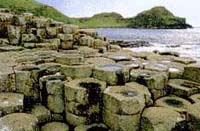Vacation Guide
Ireland golf vacation guide : To do and see
ANTRIM
Andrew Jackson Centre – a reconstructed 18th century cottage located just outside Carrickfergus. The centre is near the site of the American president’s parents’ original home. The American soldiers who trained in Carrickfergus during the Second World War are remembered here.
Ballycastle – marks the end of the Causeway coastline. The town’s "Ould Lammas Fair", commemorated in song, dates back to 1606 and still has sheep and pony sales. Ballycastle celebrates the Festival of Song and Dance each June and the Northern Lights celebration of culture in late May. Marconi established wireless contact with Rathlin Island here in 1898.
Bushmills Distillery – situated in the village of Bushmills, this is recognised as the world’s oldest licensed brewery. And though it was first officially distilling in 1608, 13th century records tell tales of soldiers being fortified with the local brew known as "uisce beatha" – the water of life.
 Carrick-a-Rede Rope Bridge – not for the faint hearted, with razorbills soaring fearlessly overhead, this bridge of ropes and slats sways 80 feet above the water and crosses over to a small island.
Carrick-a-Rede Rope Bridge – not for the faint hearted, with razorbills soaring fearlessly overhead, this bridge of ropes and slats sways 80 feet above the water and crosses over to a small island.
Carrickfergus – noted for its brilliantly positioned Norman castle, overlooking the harbour, where William of Orange landed in 1690 on route to the Boyne. The town now revels in ancient banquets, as well as the "Lúnasa Fair" on the 1st of August each year.
Donegall Square – situated in the centre of Belfast, the square is dominated by the enormous white Portland stone building of the City Hall. The City Hall was built in the Classical Renaissance style and was completed in 1906. There are a number of memorials on display in the square including statues of Queen Victoria, Edward Harland and a stone commemorating the American Expeditionary Force who arrived in 1942.
Dunluce Castle – situated in Portrush, the romantic ruins of Dunluce Castle hang on the edge of a crag. The castle originated as a Norman fortification and later became a stronghold of the MacDonnell clan. At this ruin, one can inspect the thousand-year old souterrain and original cobbled yard.
 Giant’s Causeway – known as the "eighth wonder of the world", this is Northern Ireland’s number one tourist attraction. Publicity for this geographical phenomenon dates back to 1693, while leading international geologists have vied with each other over the years to explain its origins. Mythology suggests that Fionn mac Cumhaill wanted stepping-stones to the nearby island of Staffa, where a particular female giant lived. The true origins of this unique landscape are explained in the visitors’ centre.
Giant’s Causeway – known as the "eighth wonder of the world", this is Northern Ireland’s number one tourist attraction. Publicity for this geographical phenomenon dates back to 1693, while leading international geologists have vied with each other over the years to explain its origins. Mythology suggests that Fionn mac Cumhaill wanted stepping-stones to the nearby island of Staffa, where a particular female giant lived. The true origins of this unique landscape are explained in the visitors’ centre.
Glens of Antrim – the nine Glens of Antrim run, in the immortal words of the song "Danny Boy", from glen to glen, between steep headlands and down to the sea. This is one of the most scenic landscapes in Europe and at various vantage points along the coast; you can enjoy uninterrupted views of the Mull of Kintyre and beyond.
Lagan Lookout Visitor Centre – situated in Belfast, visitors can view the Weir and the giant cranes of the Harland & Wolff shipyard, founded in 1862 by Edward Harland from Yorkshire and Wilhelm Wolff from Hamburg.
 Rathlin Island – a small island situated off Ballycastle, this thinly inhabited botanical, ornithological and geological paradise provided a retreat for Scotland’s Robert the Bruce during the 14th century battles against English tyranny. He hid in a cave in 1306 here prior to his return to Scotland.
Rathlin Island – a small island situated off Ballycastle, this thinly inhabited botanical, ornithological and geological paradise provided a retreat for Scotland’s Robert the Bruce during the 14th century battles against English tyranny. He hid in a cave in 1306 here prior to his return to Scotland.
Titanic Memorial – recalls the doomed liner, which was built at the Harland & Wolff shipyard in Belfast. Situated in Donegall Square, the monument commemorates the gallant men who perished on its maiden voyage. Belfast City Council has designated the 15th of April as "Titanic Day".
Ulster Museum – located near Belfast’s Botanic Gardens, this museum houses a unique collection of treasure, including gold jewellery from the shipwrecked Spanish Armada vessel "La Girona", as well as fascinating displays from Irish history.



